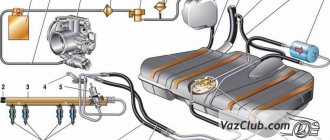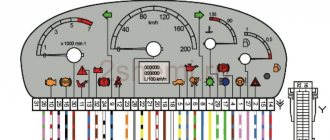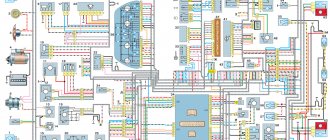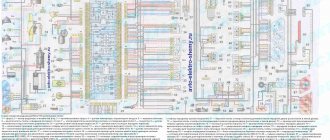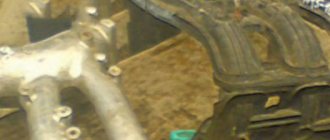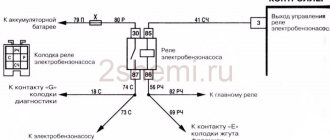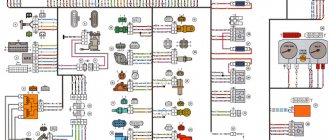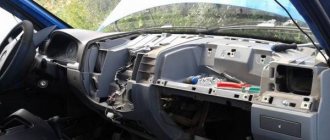Here are the control diagrams for the VAZ-21120 and 21124 engines. They were installed on Lada hatchbacks of the 2112 family. A diagram of the on-board network is also provided. We are talking about engines containing 16 valves, and the electrical circuit on the VAZ-2112 consists of separate parts: engine control, general circuit. Power supply circuit for headlights, headlights, etc. discussed in the first chapter.
We study in the video how to enable self-diagnosis of the instrument panel to check its operation.
Electrical diagram of a VAZ 2112 car
Electrical diagram of VAZ 2112 - general diagram of connecting electrical equipment and instruments, engine control unit and fuses. When servicing and repairing the engine management system of this and other VAZ family vehicles, always turn off the ignition. When carrying out welding work, disconnect the controller from the wiring harness. The controller contains electronic components that can be damaged by static electricity, so do not touch its terminals with your hands. With the engine running, do not disconnect or adjust electrical connectors.
Installation of fog lights
Car owners can independently equip their car with fog lights. To make installation easier, you can watch videos from forums where craftsmen share their experience of such work.
Conclusions: in fact, replacing old wiring in the rear of a car is much easier than in the engine compartment or inside the cabin. And the diagrams proposed in the article will help you figure it out faster and avoid mistakes.
Wiring in a car plays one of the most significant roles, since it is actually the connecting link of many functional elements of the car. In the VAZ 2110, wiring is replaced if it malfunctions, or if the owner decides to upgrade. This, in turn, will help to significantly improve the efficiency of the vehicle's electronic systems. Often, old wiring simply cannot withstand the load of various additional high-tech devices. Replacing the wiring in a VAZ 2110 can be easily done on your own.
Engine control diagram VAZ 2112
1 - ignition relay; 2 — ignition switch; 3 - battery; 4 - neutralizer; 5 — oxygen concentration sensor; 6 — adsorber with solenoid valve; 7 — air filter; 8 — mass air flow sensor; 9 — idle speed regulator; 10 — throttle position sensor; 11 — throttle assembly; 12 — diagnostic block; 13 — tachometer; 14 — speedometer; 15 — control lamp “CHECK ENGINE”; 16 — immobilizer control unit; 17- ignition module; 18 — nozzle; 19 — fuel pressure regulator; 20 - phase sensor; 21 — coolant temperature sensor; 22 — spark plug; 23 — crankshaft position sensor; 24 — knock sensor; 25 — fuel filter; 26 - controller 2112; 27 — fan switching relay; 28 — electric fan of the cooling system; 29 — relay for turning on the electric fuel pump; 30 — fuel tank; 31 — electric fuel pump with fuel level indicator sensor; 32 — gasoline vapor separator; 33 - gravity valve; 34 - safety valve; 35 — speed sensor VAZ-2112; 36 - two-way valve.
The VAZ-2112 engines and some VAZ-2111 engines are equipped with a distributed phased injection system: fuel is supplied alternately by injectors in accordance with the operating order of the cylinders, which reduces the toxicity of exhaust gases. In this case, a phase sensor is installed on the cylinder head, and a disk with a slot in the rim is installed on the camshaft pulley.
Electrical connection diagram of the ECM Russia-83 Bosch 1.5.4, January 5.1.2 VAZ-21103, 21113, 2112
- — nozzles;
- - spark plug;
- — ignition module;
- — diagnostic block;
- — controller;
- — block connected to the instrument panel harness;
- — main relay;
- — main relay fuse;
- — electric fan relay;
- — controller power supply fuse;
- — electric fuel pump relay;
- — fuse for the power supply circuit of the electric fuel pump;
- — mass air flow sensor;
- — throttle position sensor;
- — coolant temperature sensor;
- — idle speed regulator;
- - knock sensor;
- — crankshaft position sensor;
- — camshaft position sensor (phases);
- — APS control unit;
- — APS status indicator;
- - speed sensor;
- — electric fuel pump with fuel level sensor;
- — oil pressure warning lamp sensor;
- — coolant temperature indicator sensor;
- — oil level sensor;
- - block connected to the ignition system harness;
- — instrument cluster;
- — mounting block;
- — electric cooling system fan;
- — ignition switch;
A - block connected to the ABS cabin group harness; B - block connected to the air conditioner harness; C — block connected to block R of the front harness; D — wire connected to the ignition switch (backlight); E - block connected to the blue-white wires disconnected from the ignition switch; F - to the “+” terminal of the battery; G1, G2 - grounding points; L — contacts of the block to the trip computer; M - contact of the block to the on-board control system unit; N — contacts of the instrument panel harness block and the front harness; R — block connected to block C of the ignition system harness; Z - to the “B+” terminal of the VAZ-2112 car generator.
General information
The car and electricity are fused together from the very beginning. You may recall that the very first such vehicle used an electric motor, until the internal combustion engine was invented.
Wiring a VAZ 2112 makes it possible to perform actions that simply cannot be carried out without electricity.
Among them are:
- ignition of the fuel mixture in the cylinders of a carburetor and injection engine;
- starting the engine;
- operation of head lighting devices at night to illuminate the road surface;
- fog lights when driving in conditions of limited visibility;
- light indication of the instrument scale;
- side lights for vehicle detection at night;
- turn indicators;
- signaling devices.
Schematic diagram of the electrical wiring of a VAZ 2112 car (16 valve)
In addition, the wiring diagram of the VAZ 2112 will help you figure out how and what the auxiliary equipment is connected to:
- “wipers”, which allow the driver to feel normal in rainy or snowy weather;
- sound signals in case of an emergency;
- searching for a spark in case of engine failure;
- CD player and radio;
- window lifters;
- windshield and rear window heaters;
- interior lighting lamps.
The electrical wiring of the VAZ 2112 connects electrical appliances and devices with current sources located in the car. An electrical equipment system is a collection of current consumers and its producers .
Serviced battery
Car power supplies and ignition
Let's take a closer look at it, starting with the most important elements:
A rechargeable battery is a chemical source of energy, which is a lead-acid DC battery module. The photo shows a battery being serviced. Usually there are six of them.
It is used for:
- starting the engine with an electric starter;
- supplying power to electrical equipment when the engine is not running or when it is running at low crankshaft speeds.
Generator . Used as the main source of current for all electronic and electrical devices and instruments in the car. But, it can provide this only at medium or high crankshaft speeds. The price of this equipment depends on the manufacturer.
Ignition system . Designed to ignite fuel in engine cylinders. Can be contact or non-contact. Modern VAZ 2112 cars are equipped with the latter version, which has a number of advantages over the contact system, which is already considered obsolete.
The main advantages should be noted:
- increased voltage potential supplied to the secondary winding of the ignition coil;
- increased power and longer spark discharge duration;
- increased service life of the spark plug;
- the breaker contacts practically do not fail;
- fuel burns better in the cylinders, which saves money as a result;
- makes engine starting easier;
- the engine becomes more responsive and more economical.
Starter relay installation diagram
If the battery is not charging
When the battery is no longer charged, it does not allow the car to be used for a long time. Maximum until it is completely discharged. In this case, a red light comes on on the instrument panel, which signals that the wiring on the VAZ 2112 requires checking.
The instructions below will help with this:
- Check the generator drive belt, it should be intact and have the required tension.
Advice: it is not recommended to apply too much tension; it will significantly shorten the life of the belt.
- If everything is fine, check the fuse. The VAZ 2112 wiring diagram for 8 or 16 valves, as well as the reverse side of the mounting block cover, will help you find out where it is located. After replacing it and starting the engine, the lamp should go out, allowing you to continue your journey.
Checking and replacing the fuse
- When the charging lamp does not go out, check the wire from the generator to the “+” terminal of the battery. There are usually two of them:
- thick – from the battery to the starter,
- thin - to the generator.
It should not be broken or have oxidized contacts . It happens that there is no way to fix the breakdown, which means that the generator itself needs to be repaired. Repairs must not be delayed as a short circuit may occur. But it’s better to do this at a service station or at home in the garage with your own hands.
Advice: when driving only on battery power, to reduce on-board electricity consumption, turn off as many devices as possible - radio, heater fan, etc.
Fuses and relays 2112
Fuse number Current strength, A Protected circuits
- F1 5 License plate lamps. Instrument lighting lamps. Side light indicator lamp. Trunk light. Left side marker lamps
- F2 7.5 Left headlight (low beam)
- F3 10 Left headlight (high beam)
- F4 10 Right fog lamp
- F5 30 Electric door window motors
- F6 15 Portable lamp
- F7 20 Electric motor of the engine cooling system fan. Sound signal
- F8 20 Rear window heating element. Relay (contacts) for turning on the heated rear window
- F9 20 Recirculation valve. Windshield and headlight cleaners and washers. Relay (coil) for turning on the rear window heating
- F10 20 Reserve
- F11 5 Right side marker lamps
- F12 7.5 Right headlight (low beam)
- F13 10 Right headlight (high beam). High beam warning lamp
- F14 10 Left fog lamp
- F15 20 Electric seat heating. Trunk lock lock
- F16 10 Relay-breaker for direction indicators and hazard warning lights (in emergency mode). Hazard warning lamp
- F17 7.5 Interior lighting lamp. Individual backlight lamp. Ignition switch illumination lamp. Brake light bulbs. Clock (or trip computer)
- F18 25 Glove box lighting lamp. Heater controller. Cigarette lighter
- F19 10 Door locking. Relay for monitoring the health of brake light lamps and side lights. Direction indicators with warning lamps. Reversing lamps. Generator excitation winding. On-board control system display unit. Instrument cluster. Clock (or trip computer)
- F20 7.5 Rear fog lamps VAZ-2112.
- K1 – lamp health monitoring relay;
- K2 – windshield wiper relay;
- K3 – relay-interrupter for direction indicators and hazard warning lights;
- K4 – headlight low beam relay; K5 – headlight high beam relay;
- K6 – additional relay;
- K7 – relay for turning on the heated rear window;
- K8 – backup car relay.
How to upgrade them
- The good news is that we will no longer need conductive tape - neither new nor old. In any case, AvtoVAZ itself abandoned this “karmically” unsuccessful detail in the design of the rear lights of the VAZ 2114 or VAZ 2115 models.
- The bad news is that your car with such tape in the headlamp unit may present an unexpected and unpleasant surprise at the most inopportune time.
But there is a way out - to modernize it yourself, and in fact simplify the design of the rear lights.
Penny purchases
- costs less than the original. And the proposed method will allow you to keep it within 250 rubles;
- simplifies the design. That’s how it will be, because it’s not for nothing that this method is used everywhere.
- a set of single sockets for direction indicators;
- double sockets for brake lights and parking lights;
- male-female copper connectors;
- high-quality wire 2-3 meters.
Independent steps
Having removed the rear lights from the car, we begin to modernize them. To do this, you will need instructions that will show you how to remove the lighting fixture.
Don't forget that modern cars are full of plastic parts that can easily be broken due to carelessness. When dismantling, try to do everything carefully
Note! You will need a wiring diagram for the VAZ 2112 injector, and the good news is that it is posted at the beginning of the article.
Locksmith stage
- in the plastic panel of the headlight housing we mark places for cartridges;
- then we cut holes for them;
- We fix them with self-tapping screws.
Electric stage
- We cut off a piece of wire and use it to make a common “ground”. To do this, we connect the “-” terminal of all cartridges in series, having previously secured the male-female connector to the wire;
- Cut the wire again and connect it to the “+” turn terminal;
- Using the next piece of wire we connect the “+” terminal of the side and stop lights in series;
- Referring to the diagram, we connect the connector block with the free ends of the wiring.
Tip: be sure to test the assembled circuit to identify a short circuit.
VAZ-2112 diagram
The VAZ-2112 car was produced at AvtoVAZ from 1998 to 2009, in Ukraine from 2009 to 2014. The following are color wiring diagrams (injector and carburetor) with a description of all elements for various modifications. The information is intended for self-repair of cars. Electrical circuits are divided into several blocks for ease of viewing via a computer or smartphone; there are also circuits in the form of a single picture with a description of the elements - for printing on a printer in one sheet.
To diagnose and repair yourself, first look to see if everything is okay with the generator. Is it put on well and does not sag? This procedure must be done with all versions of the fuel system, both carburetor and injection. We check the fuses according to the electrical diagram. The reverse side of the safety block cover will also be of great help. There are clues there that the diagram will help you decipher. Replace the burnt out element and try to start the car again. You need to check whether the battery terminals are tightly connected and whether they are oxidized. Is the wire going from the battery to the generator and to the starter damaged?
Unbreakable connection
The machine and its electrical circuit cannot exist separately; this union is inviolable, like the foundation of a Chinese wall.
Almost all systems depend on electricity in one way or another, and in its absence, they not only refuse to work properly, but do not work at all.
Here are just a few of these interactions:
- ignition of the fuel mixture in the fuel system of both carburetor and injection types;
- supplying electricity to the starter when starting the engine;
- night lighting of the instrument panel;
- inform other road users about the desire to perform a maneuver using the light direction indicator “right” or “left”;
- turn on the sound signal to prevent an accident;
- turn on your side lights to identify your vehicle at night.
Let's move on to the connection diagram itself.
By the way, the presence in the “Manual” of printed circuit diagrams with detailed descriptions makes it an indispensable assistant not only for accurately determining symptoms, but also for “prescribing treatment”, finding out the most important question, why it hurts, and not only where.
According to our diagram, it is important to understand what the following auxiliary equipment is connected to:
- sound signal;
- wipers;
- radio or radio;
- interior lighting;
- heated rear and front windows;
- power windows (if equipped).
The task is important for the reason that in a car there is a certain interdependence of some (main) systems from others (auxiliary). Some work in pairs, others in threes or even fours. If you know this connection exactly, you will immediately find your path. If the glow plugs are not receiving power, then most likely other subsystems operating in the same housing are also not working for you.
Modifications of the VAZ-2112 car
VAZ-21120 . Modification with a 16-valve injection engine with a volume of 1.5 liters and a power of 93 horsepower. 14-inch wheels were installed on the car. This modification has a problem with valves bending when the timing belt breaks. The problem can be solved by increasing the depth of the grooves in the piston bottoms.
VAZ-21121 . The car was equipped with a VAZ-21114 8-valve injection engine with a volume of 1.6 liters and a power of 81 horsepower.
VAZ-21122 . Budget modification with an 8-valve injection engine VAZ-2111. The car was produced without electric windows, the wheels were 13 inches in size, and the brakes were unventilated from a VAZ-2108 car.
VAZ-21123 Coupe . Three-door, five-seater hatchback. The only two doors for entering the car are 200 millimeters wider than those of the five-door hatchback, and they are mounted on new, durable hinges. The rear arches of the car have become wider. The engine was installed with a 16-valve injection engine with a volume of 1.6 liters and a power of 90 horsepower. The car was produced from 2002 to 2006 in small quantities, the reason for this was the high cost of the car.
VAZ-21124 . Modification with a 16-valve injection engine VAZ-21124 with a volume of 1.6 liters. Produced from 2004 to 2008. For this type of engine, the problem with valve bending was solved. To do this, the depth of the grooves in the piston heads was increased (up to 6.5 mm). In addition, the design of the cylinder block was changed to achieve a working volume of 1.6 liters, for which its height was increased by 2.3 mm, and the radius of the crankshaft was increased by 2.3 mm accordingly. There were also a number of other minor changes.
The car does not start - there is no charge in the battery
This problem occurs because the battery power is lost somewhere. It doesn't disappear randomly, but always for some reason.
Here are some of them:
- leave the car outside at ambient temperatures of -20 degrees and below;
- the battery is running low;
- For some time, the radio was working in your cabin, which led to the loss of charge.
In all these cases, two types of treatment are usually used: firstly, urgently recharge, and secondly, buy a new battery. If you drag and drive with a dead battery, soon you won’t even be able to disarm the car. You will have to manually remove the terminals in an attempt to plug it. The situation will improve as soon as the battery is charged.
Electrical diagram of VAZ-2112
Designations: 1 – Headlight, 2 – Klaxon, 3 – Main radiator fan, 4 – Starter, 5 – Battery, 6 – Generator 2112, 7 – Gearbox limit switch (reverse), 8 – Actuator in the front passenger door, 9 – Power window enable relay, 10 – Starter relay, 11 – Heater fan, 12 – Electric heater partition drive, 13 – Main pump, 14 – Washer reservoir sensor, 15 – Driver’s door actuator, 16 – Front passenger window selector, 17 – Unlock button fifth door, 18 – Heater fan resistance unit, 19 – Main wiper motor, 20 – Driver’s window lift selector, 21 – Front passenger’s window lift motor, 22 – Central locking, 23 – Exterior light switch, 24 – Brake fluid leakage sensor, 25 – Pump additional, 26 – Driver's window lift motor, 27 – PTF on indicator, 28 – PTF switch, 29 – Dashboard, 30 – Heated glass on indicator, 31 – Heated glass switch, 32 – Steering column selector switch, 33 – PTF relay, 34 – Ignition switch, 35 – Main fuse block, 36 – Illumination of heater controls, 37 – Hazard warning button, 38 – Heater control controller, 39 – Glove compartment lighting, 40 – Glove compartment lid end cap, 41 – Cigarette lighter, 42 – BSK – display unit, 43 – Ashtray illumination, 44 – 12V socket, 45 – Instrument lighting switch, 46 – Actuator in the right rear door, 47 – Right rear passenger window selector, 48 – Clock, 49 – Right rear passenger window motor, 50 – Brake limit switch (closed – pedal is pressed), 51 – Left rear passenger window motor, 52 – Left rear passenger window selector, 53 – Actuator in the left rear door, 54 – Turn signal, 55 – Handbrake limit switch (closed – handbrake on), 56 – Rear wiper motor , 57 – Navigator's lamp, 58 – Interior lamp, 59 – Temperature sensor in the heater, 60 – Limit switch for the open front door, 61 – Limit switch for the open rear door, 62 – Trunk light, 63 – Rear optics (on the body), 64 – Rear optics (on the fifth door), 65 – License plate illumination.
The letters indicate the terminals to which it is connected: A – Front speaker on the right, B – Radio, C – Injector harness, D – ESD diagnostic connector, D – Front left speaker, E – Diagnostic connector for the heater controller, G – Rear right speaker, W – Rear left speaker, I – BC connector, K – glass heater thread, L – fifth door actuator, M – Additional brake light.
Wiring diagram VAZ-2112 injector 16 valves - full view
Basic principles
Regardless of whether your VAZ 2110 has a carburetor or an injector, the basic principles for laying the wiring are the same. Finding a wiring diagram is not at all difficult, the main thing is to understand it. Actually, according to the location, the wiring is under the hood and in the cabin.
Its basic principles are the same, and boil down to the following:
- Whatever electrical device you have in a car, its connection will be single-wire. Moreover, the creators of the VAZ 2110 from the very beginning provided that both in the diagrams in the instruction manual and in reality, the colors of the wires would be clearly distributed. Simply put, all electrical equipment is connected using wires of a clearly defined color. Each unit has its own wiring harness enclosed in blocks. Naturally, this was done so that it would be easier for those who do the repairs themselves to understand this intricacy. Thus, replacing the wiring under the hood becomes more understandable. Advice: if you have a small problem with specific equipment and only one wire needs to be replaced, it is better not to be greedy and not change it to the first one you come across. Buy a complete harness and replace it with the wire of the desired color - it will be easier for you later;
- the wire supplying power to the positive terminal of the battery is always braided in red; it is also advisable not to change its color. In all diagrams it is designated as “P”, that is, plus;
- but the role of the “minus” (in other words, mass) is assigned to the automobile body;
- all terminals of any electrical consumers are directly connected to the body;
- Each system that is electrically connected has its own wiring harness.
In the VAZ 2110, if the battery is connected, all electrical equipment is energized. That is why, in fact, before starting any repair (especially if it is related to the electrical part of the car), it is strongly recommended to disconnect the battery.
VAZ-21124 engine control circuit
Connection diagram of the VAZ-21124 engine control system with distributed fuel injection to Euro-2 emission standards (controller M7.9.7): 1 - ignition coils; 2 — nozzles; 3 - controller; 4 - main relay; 5 - fuse connected to the main relay; 6 — cooling system electric fan relay; 7 - fuse connected to the cooling system electric fan relay; 8 - electric fuel pump relay; 9 - fuse connected to the electric fuel pump relay; 10 — mass flow and air temperature sensor; 11 — throttle position sensor; 12 — coolant temperature sensor; 13 — solenoid valve for purge of the adsorber; 14 — oxygen sensor; 15 — knock sensor; 16 — crankshaft position sensor; 17 — idle speed regulator; 18 — immobilizer control unit; 19 — immobilizer status indicator; 20 - phase sensor; 21 — vehicle speed sensor; 22 — electric fuel pump module with fuel level sensor; 23 — oil pressure warning lamp sensor; 24 — coolant temperature indicator sensor; A - block connected to the wiring harness of the ABS cabin group; B — diagnostic block; B - block connected to the air conditioner wiring harness; G - to the “+” terminal of the battery; D — to the side door wiring harness block; E - block connected to the instrument panel wiring harness; G1, G2 - grounding points; I - the order of conditional numbering of plugs in the block of the immobilizer control unit; II - the order of conditional numbering of contacts in the diagnostic block.
Prevention
If you suspect a malfunction, you need to check the resistance of the high-voltage wires using a multimeter. The black wire must be installed in the left hole, in the middle - the red one. The multimeter should be in the blue 20 position, the probes should be connected to each other.
If the resistance is zero, then everything is in order. If the multimeter needle shows 1, it means that the resistance is higher than the limit, such a wire must be replaced. Moreover, keep in mind that different wires can produce different resistance due to the difference in length.
Since the engine compartment environment is aggressive, even if one of the high-voltage wires produces increased resistance, you need to change all the wires on the VAZ 2110, because if one fails, then the others will soon fail as well.
It’s not at all difficult to make the replacement yourself; you just need to be careful and attentive. And we remind you once again: before reaching into the wires, disconnect the battery!
VAZ-2112 harness diagrams
Instrument panel harness diagram
1, 2, 3, 4 – instrument panel harness pads to the front harness; 5 — block of the instrument panel harness to the side door harness; 6, 7, 8 — instrument panel harness pads to the rear harness; 9 – rear window heating switch; 10 – light signaling switch; 11 – windshield wiper switch; 12 – block of the instrument panel harness to the radio; 13 – mounting block; 14 — instrument cluster; 15 – heater control controller; 16 – heater motor switch; 17 — block of the instrument panel harness to the ignition system harness; 18, 19 — blocks of the instrument panel harness to the air supply box harness; 20 — ignition switch; 21 – fog lamp relay; 22 – sound signal relay; 23 — power window relay; 24 — starter relay; 25 – seat heating relay; 26 – external lighting switch; 27 – fog lamp switch; 28 – cigarette lighter; 29 – lampshade lighting of the glove box; 30 – glove box lighting switch; 31 – switch for rear fog lights; 32 – right steering column switch; 33 – socket for connecting a portable lamp; 34 — instrument lighting switch; 35 – brake signal switch; 36 – sound signal switch; 37 – alarm switch; 38 – air distribution drive gearmotor; 39 – VAZ-2112 illuminator; 40 — instrument panel harness block to the front harness; 41 – trunk lock drive switch; 42 – rear fog light relay.
A – grounding point of the instrument panel harness.
Source
Replacing the wiring harness in the rear of the car
The vehicle's owner's manual warns that adverse weather conditions may adversely affect the vehicle's electrical components. And connectors and electrical cables are among the first to suffer.
Girls in revealing dresses are a favorite “bait” of scammers
And since the price of spare parts is low, the car owner can replace:
- Rolled terminal block;
- Broken insulating wire;
- Units and accessories are approved for installation on other models of the VAZ family.
Wiring diagram for VAZ 2112 - wiring and connectors for the rear of the car
Tip: This requires a VAZ 2112 wiring diagram with decoding in order to clearly understand which electrical circuit is responsible for what and controls what.
Rear Harness Terminal Blocks
Let's take a closer look at the diagram above:
- general wiring terminal block for connecting wiring coming from the instrument panel (in diagram No. 1);
- terminal block for wiring for connection to the electrical wiring of the instrument panel of cars in the “standard” configuration and for connection to the wiring of the side doors for cars in the “luxury” configuration (in diagram No. 2);
- rear wiring terminal block for connection to instrument panel wiring (No. 3);
- two 4-pole terminal blocks (for modifications 2112-3724558-10 16 valves). Marked on the diagram under No. 4 and item 5;
- side direction indicators (under No. 6 - left), under No. 7 - right);
- power supply for the individual lighting lamp (number 8 in the diagram);
- power supply unit for general interior lighting (item 9);
- handbrake sensor connector (No. 11);
- rear lights (in the diagram No. 11 - on the left, No. 12 - on the right);
- connector for the temperature sensor in the cabin (No. 13 in the diagram);
- connector for connecting 4 internal switches for the light ceiling (in the diagram nos. 14,15,16 and 17);
- trunk light connector (No. 18);
- mounting unit for backup power (in diagram No. 19). Can be used as a connector to connect to the side door harness;
- block for connecting the license plate lighting wiring harness (no. 20 in the diagram);
- The wiring grounding points are indicated in the diagram as A and A1.
Wiring an additional wiring harness for VAZ 2112
Individual wiring parts must also be replaced with your own hands. In particular, additional wiring in the trunk of the car (pictured below).
Connects to the network:
- rear window heating system;
- electric rear wiper gear;
- additional brake light;
- trunk lock motor.
Connection diagram for VAZ 2112: lighting and electrical equipment of the trunk
Electrical wiring VAZ 2112 this wiring has the following designations:
- via terminal block n. 1, the harness is connected to the main harness of the car. Includes 4 wires: red, yellow-blue, white-blue and pink-black;
- it is similar in functionality and there is no block. 2. Uses wires: green, white, black and red;
- terminal no. 3 is responsible for operating the electric motor unit and switching the rear wiper. The contacts are powered by 4 wires: black, pink-black, yellow-blue and white-blue;
- to connect the rear lights, the terminal blocks specified in paragraphs 4 and 5 are used;
- terminal no. 6 turns on the trunk lock motor. Wires: black and white;
- terminal block no. 7 is responsible for connecting the heated rear window (two red wires);
- The additional brake light is powered from terminal block No. 8 (black and red wires).

